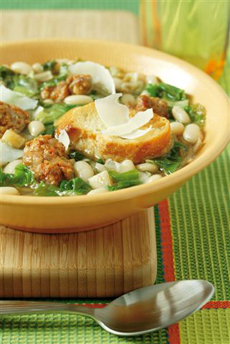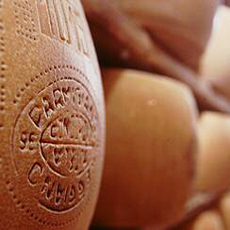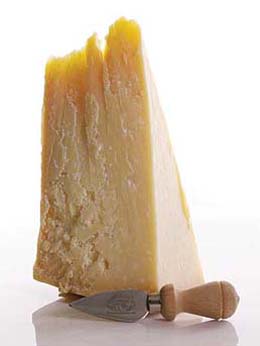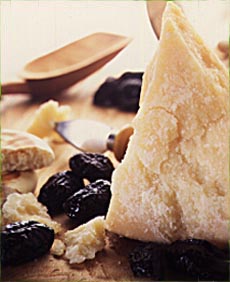

Thick curls of grated Parmesan cheese and a crouton garnish Italian Wedding Soup With Turkey Meatballs. Photo courtesy Lewis & Neal.
|
STEPHANIE ZONIS focuses on good foods and the people who produce them. KAREN HOCHMAN is Editorial Director of THE NIBBLE.
|
|
September 2007
Updated July 2012
|
 |
Grated Cheese: It’s Great To Grate
Page 4: Grated Parmesan Cheese & Parmigiano-Reggiano
This is Page 4 of an eight-page article on grated cheese. Click on the black links below to visit other pages.
Parmigiano-Reggiano Cheese
We previously featured an article entirely about Parmigiano-Reggiano, which cheese experts consider one of the great cheeses in the world (first made in the 15th century, it has vied with Roquefort for the title, “King of Cheeses,” for hundreds of years).
Italy’s most famous D.O.P.-designated cheese, true Parmigiano-Reggiano is a raw cow’s milk cheese that can only be produced in the towns of Parma and Reggio Emilia in the Italian region of Emilia Romagna by a skilled cheese maker, who is a member of a self-governing body of dairies called the Consorzio Formaggio Parmigiano-Reggiano.
|
|

Wheels of Parmigiano Reggiano. Photo courtesy Parmigiano-Reggiano.it. |
Regulations for producing Parmigiano-Reggiano are quite strict. For example, the milk must be heated in copper kettles, the starter culture for the cheese must be made in each dairy from the previous day’s whey† and the certified cheese makers, who can oversee a maximum of seven kettles at a time, have all undergone apprenticeships for at least ten years.
The minimum aging period for Parmigiano-Reggiano is 12 months; most is aged for at least 18 months. We like it best between 20 and 30 months. By then, the café au lait-colored insides have dried to crunchy perfection: nutty, spicy, salty (but not too much so) and floral, with a distinct caramel finish. Don’t be tempted by super-aged Parmigianos—they can be found up to five years old, but they tend to be dried out and salty.
†A fun food fact: The excess whey from producing Parmigiano-Reggiano is fed to the hogs whose legs will become prosciutto di Parma.
Incidentally, please do not confuse Parmigiano-Reggiano with “Parmesan.” Anyone, anywhere can make “Parmesan” cheese. It may vaguely resemble Parmigiano-Reggiano, but if someone tries to tell you they’re the same thing, don’t buy a used car from that individual! Parmesan is much cheaper than genuine Parmigiano-Reggiano and invariably of lesser quality. It doesn’t have the distinct aroma or glorious flavor of the real McCoy, although it can be used for grating. Parmesan is often excessively salty, and it lacks the “nutty” quality of and flavor nuances of an authentic Parmigiano-Reggiano.
Pairing Parmigiano-Reggiano With Food
One rarely needs an excuse to grate delicious cheese over a dish, but here are some of our favorite uses.
|
|

Parmigiano Reggiano. Photo courtesy MurraysCheese.com. |
- Always grate the cheese onto the food right before serving. As appropriate, let people grate the cheese themselves at the table: onto eggs, Caesar and other salads, soups, casseroles, stews, risotto, pasta, potatoes and other vegetables.
- You can cook it into sauces, soups, stews and eggs as well. The entire rind is edible and should not be wasted—toss it into the soup or pasta sauce pot (but remove it before serving).
- These applications are true for all of our grating cheeses: They easily substitute for one another. Although there are significant differences in flavor and cost when they are stacked shoulder-to shoulder (or rind-to-rind), the beauty is that, like Barbera, Barbaresco, Barolo and Chianti, when you don’t have one, you’ll happily use what you do have.
A Great Alternative To Grating
Parmigiano-Reggiano is considered one of the world’s great table cheeses. Italians are chagrined that Americans limit the King of Cheeses to grating on pasta.
In Italy and elsewhere, it has a place of honor, along with Brie and Roquefort, on the cheese plate. The Italian gourmet will crave only a few chunks of aged Parmigiano, some fine balsamic vinegar or artisan honey for dessert.
- It can be served with fruit (especially figs, pears, grapes or dried fruit such as prunes, as shown in the photo at right); but no bread is needed.
- Or, add it to the cheese board along with a variety of different cheeses—a young chèvre, a semisoft cheese like Brie and a washed rind cheese, for example.
|
|

Parmigiano Reggiano. Photo courtesy Prugnedellacalifornia.it. |
Wine Pairing
Profound Parmigiano needs a substantial red wine. Any of the robust wines of Italy will do—the big-bodied Barolos and Chiantis (and California Cabernets) and the robust Barbaresco, Barbera, Brunello and others. For dessert, we also enjoy it with Tawny Ports.
Specialty Parmigiano-Reggiano
Fanticini kosher-certified Parmigiano-Reggiano is made in Italy under the supervision of the Beth-Din of Milano. Read our full review. They also carry an organic Parmigiano-Reggiano. Vacche Rosse (pronounced VAHK-kay ROHS-say, “red cows”), the crema de la crema of Parmigianos, is made in very limited quantity from a small herd of cows that were brought back from near-extinction over the last 20 years. Their milk is much richer, and the Parmigiano made from it is well worth the extra money. It’s a table cheese rather than a grating cheese—unless you’re grating it over a truffle risotto.
To add to your knowledge of the King of Cheeses, read the history of Parmigiano-Reggiano, a cheese enjoyed by the nobility 700 years ago, accessible to everyone today.
Continue To Page 5: Grana Padano Cheese
Go To The Article Index Above
Lifestyle Direct, Inc. All rights reserved. Images are the copyright of their respective owners.

|







